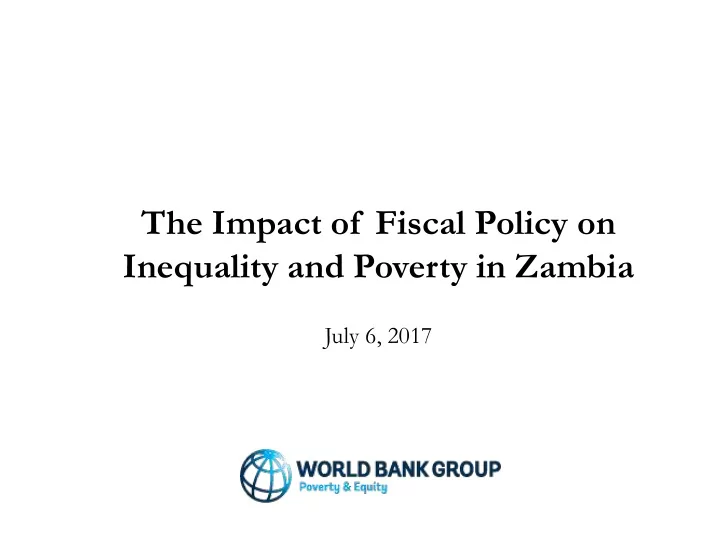

The Impact of Fiscal Policy on Inequality and Poverty in Zambia July 6, 2017
Why conduct a study of fiscal incidence in Zambia? 2
What sort of policy relevant question this study aims to answer? (i) What is the impact of taxes and transfers on inequality and poverty? (ii) What is the contribution of specific fiscal interventions to the overall impact? (iii) What is the impact on inequality and the poor of simulated fiscal policy reforms? 3
Methodology • Fiscal incidence analysis that relies on the Commitment to Equity Approach Methodology ▪ Accounting approach: no behavioral responses; no general equilibrium nor inter-temporal effects, but it incorporates assumptions to obtain economic incidence (not statutory) ▪ Point-in-time ▪ Mainly average incidence; a few cases with marginal incidence ▪ Direct Identification in microdata (However, results must be checked: how realistic are they?). If information not directly available in microdata, then: Simulation, Imputation, Inference, Prediction, Alternate survey, Secondary sources. 4
Fis iscal In Incidence Analysis Income Taxes Transfers after taxes and transfers Y h = I h - ∑ i T i S ih + ∑ j B j S jh Share of Share of tax i Income transfer j paid by unit before taxes received by h and transfers unit h 5
Income Concepts Considered MARKET INCOME PLUS DIRECT TRANSFERS MINUS DIRECT TAXES DISPOSABLE INCOME PLUS SUBSIDIES MINUS INDIRECT TAXES CONSUMABLE INCOME PLUS MONETIZED VALUE OF PUBLIC SERVICES: EDUCATION & HEALTH Higgins and Lustig. “ AAllocating Taxes and Transfers, Constructing Income Concepts, and Completing Section C of CEQ Master Workbook ” in Lustig FINAL INCOME (editor) Commitment to Equity Handbook. A Guide to Estimating the Impact of Fiscal Policy on 6 Inequality and Poverty , Tulane University, Fall 2016.
Data Sources ▪ Micro-data set with household or individual budgets: 2015 LCMS, 2013-14 DHS ▪ Budget figures, MTEF, Annual Economic Performance Report ▪ Administrative data at the program level: SCT FISP, Fuel, Electricity subsidy spending Education Statistical Abstract Health Statistical Abstract ▪ Third-party reporting and secondary sources: SCT evaluations 7
Main Results ▪ Fiscal policy in Zambia reduces inequality, mainly when in-kind transfers are taken into account (though the underlying causes are not necessarily positive - lower pre-fiscal incomes and higher dependency ratios for education & more proneness to sickness). ▪ But impoverishes the majority of the population because their net contributions to the fiscal system were larger than net receipts. ▪ Direct cash transfers are too small to make a dent on poverty. ▪ Subsidy expenditures are almost completely concentrated in rich households, and yet they only provide a marginal boost to rich households incomes. This is a huge opportunity cost: an equally- sized transfer delivered to the poorest 10 percent would provide them an income boost of about two-fifths of disposable income.
The fiscal system reduces inequality… Fiscal Policy’s Impact on Inequality (Gini coefficient), 2015 9
But increases poverty Fiscal Policy’s Impact on the Poverty Headcount Ratio, 2 015 10
Fiscal impoverishment happens because most (poor and vulnerable) households receive less from the fiscal system than they pay into it (in cash terms) All benefits, subsidies, and indirect taxes as a share of disposable income 11
Income taxes are borne by rich households; indirect taxes (VAT, Excise) are borne by everyone. Concentration shares of total taxes collected, by decile and by tax 12
Poor and non-poor households capture unequal shares of the available in-kind benefits Total in-Kind Expenditures by Education Level and Health Facility Type (%) 13
SCTS is pro-poor, but provides low coverage and the top 60 percent still captures 2/5ths of program benefits Share of SCT-eligible and SCT-receiving households, by decile (left to right: poorest to richest deciles) 14
FISP is a more important income source than cash transfers for all but the poorest households 10% FISP: incidence SCT: incidence 9% 8% 7% 6% 5% 4% 3% 2% 1% 0% 1 2 3 4 5 6 7 8 9 10 SCT and FISP benefits received as a share of disposable income (by decile) 15
Energy subsidies – especially fuel subsidies – are received by rich households; FISP is concentrated in the middle of the income distribution Electricity, Fuel, and FISP Subsidy Coverage Rates, 2015 Percent of households receiving subsides 16
Main Results of Fiscal Policy Reform Simulations Fiscal Reforms and Poverty, Inequality Impacts @ Consumable Income @ Disposable Income Poverty Poverty Poverty Poverty Inequality Inequality Headcount Gap Headcount Gap Current/2015 54.4% 0.26 0.546 56.3% 0.28 0.543 Partial 53.9% 0.25 0.539 56.0% 0.27 0.534 Full 50.3% 0.24 0.539 53.3% 0.25 0.537 Source : Authors’ estimates based on LCMS 2015. Notes: “Partial” reform includes the elimination of fuel and electricity subsidies and an increase in coverage of the SCT pro gram to 500,000 beneficiaries, and a 28 percent increase in SCT benefit levels. The increas ed SCT cost under “partial” reform represents 7 percent of foregone energy subsidy expenditures. “Full” reform includes the elimination of fuel, electricity, and FISP sub sidie and an increase in coverage of the SCT program to 500,000 beneficiaries, and a 100 percent increase in SCT benefit levels. Th increased SCT cost under “full” reform represents 18 percent of foregone energy and FISP expenditure.
Eliminating all subsidy spending and increasing SCT coverage and benefit levels would lead to the bottom 1/3 rd becoming net recipients All benefits, subsidies, and indirect taxes as a share of pre-fiscal income after subsidy elimination and 18 compensatory SCT transfers
Recommend
More recommend